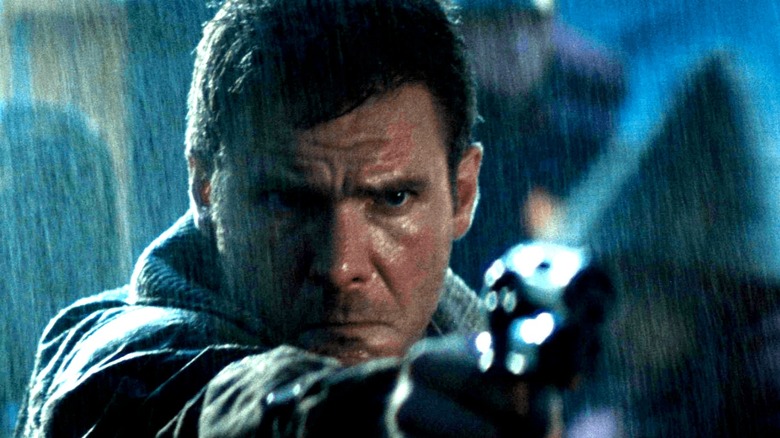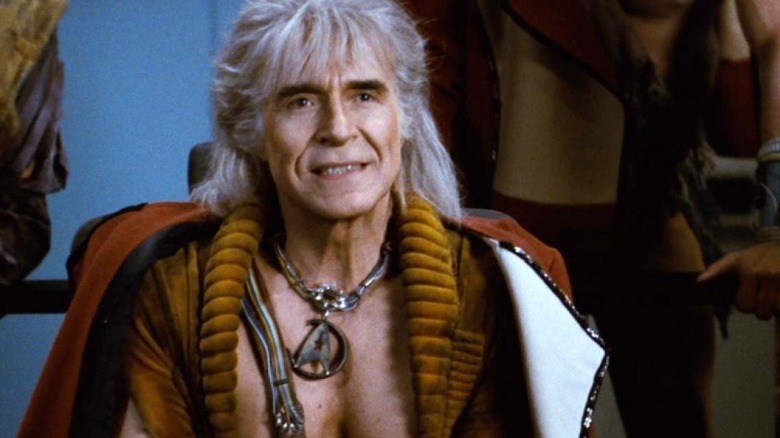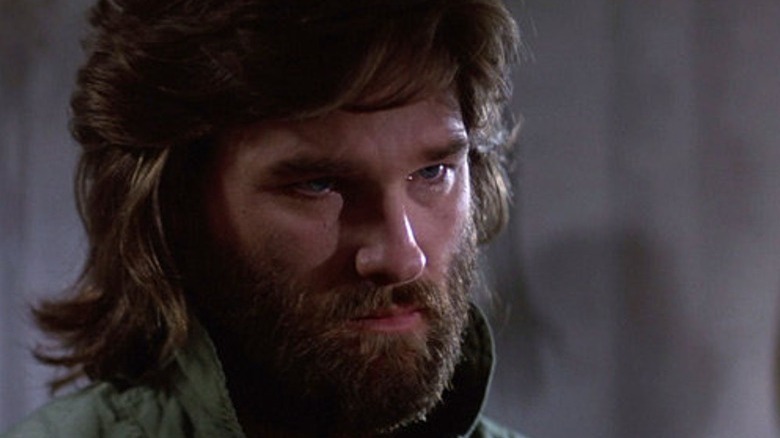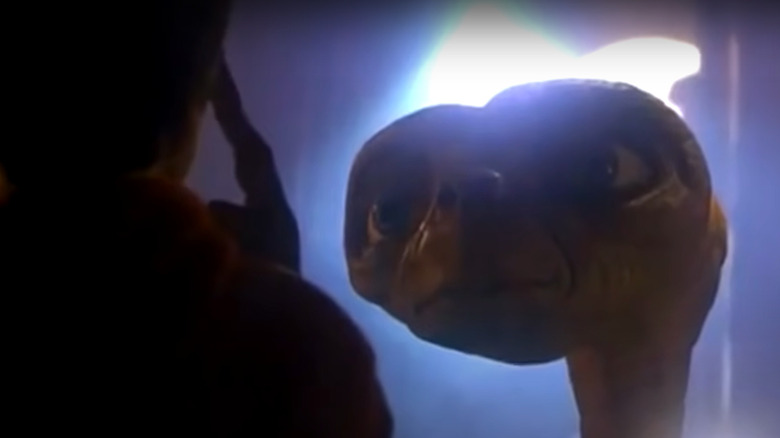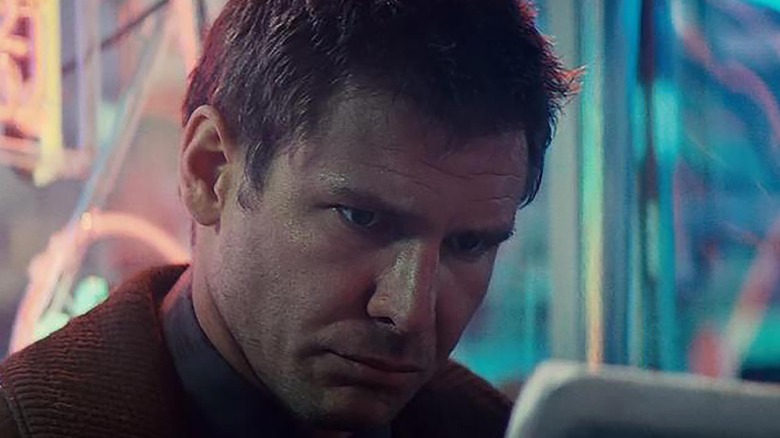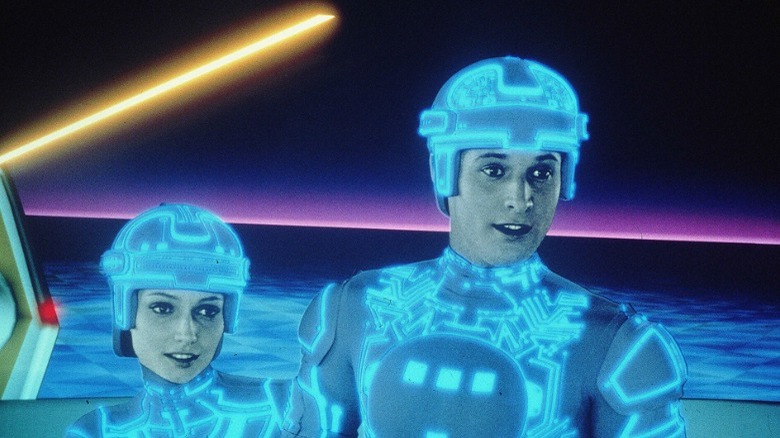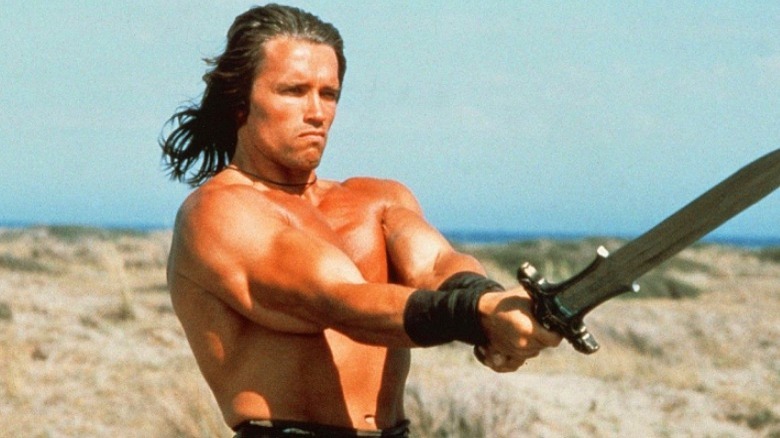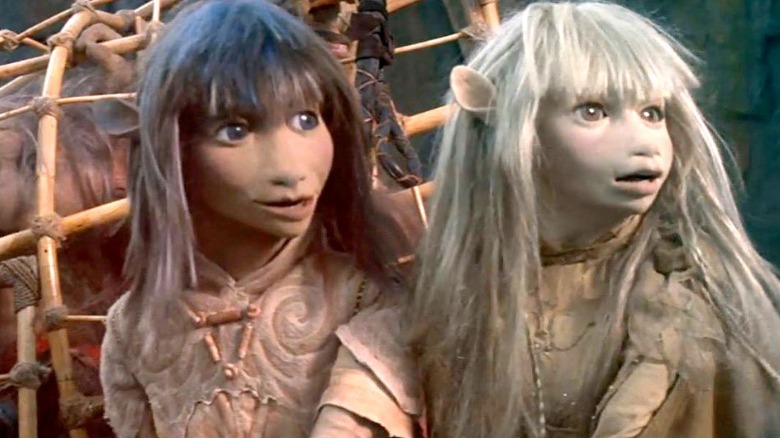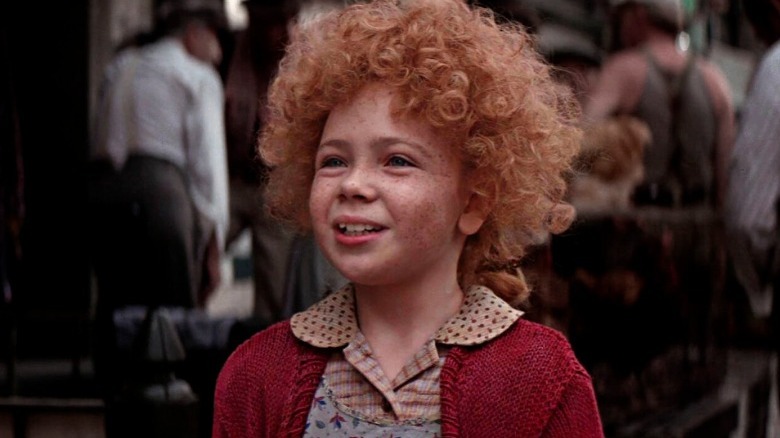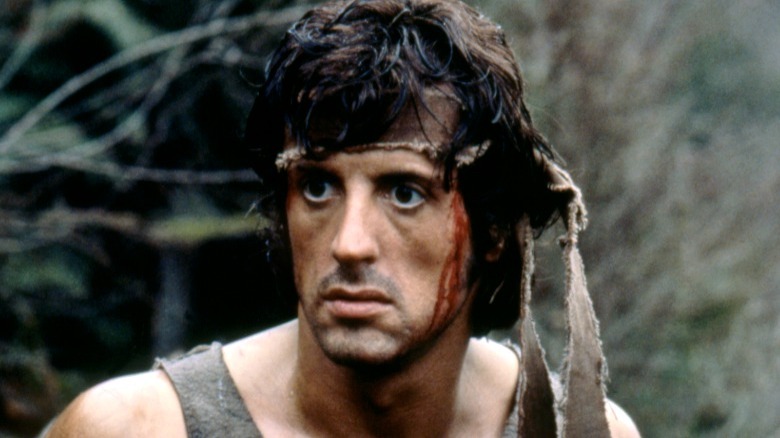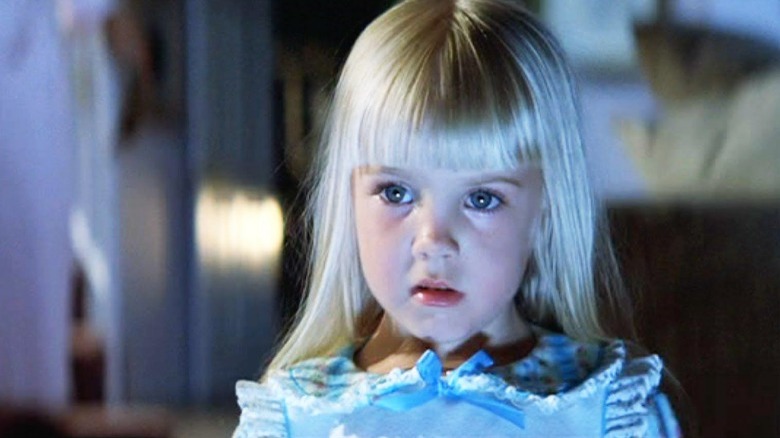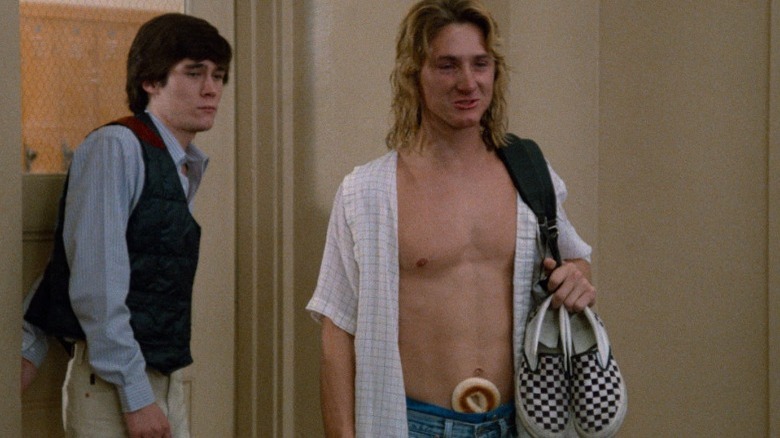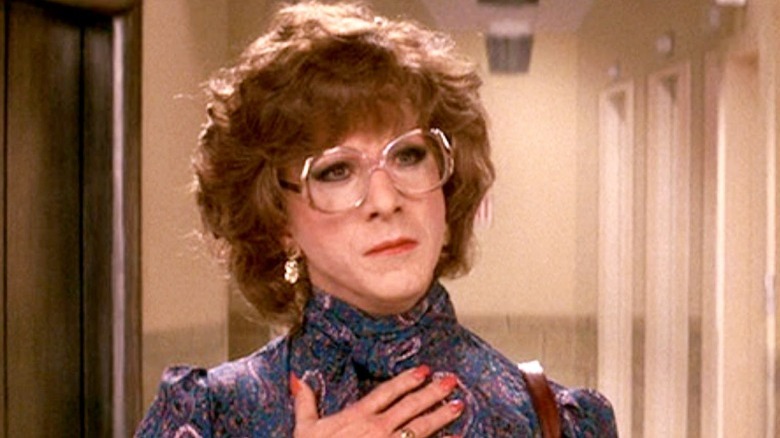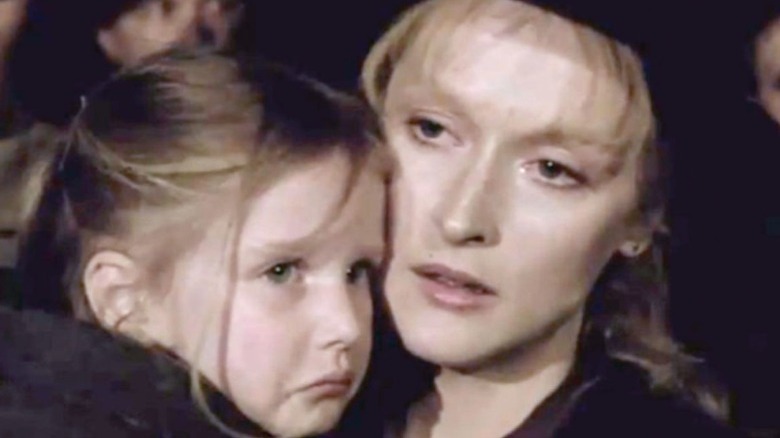The Best Movies Turning 40 In 2022
The year is 2022. It sounds like the intro of an apocalyptic sci-fi thriller, doesn't it? In fact, according to the twisted timeline of the "Terminator" franchise, we should've already experienced a handful of Judgement Days by now. Thankfully, we aren't knee-deep in the bones of our neighbors fending off Skynet quite yet.
The '80s gave us plenty of mega-blockbuster hits, pop culture mainstays, and iconic genre-defining tales for the ages. And if we were to wind back the clock 40 years, we'd land in 1982: a year that helped define futurism, fantasy, music, and comedy on the big screen. 1982 mostly pre-dates the era of big flashy CGI animation. Instead, filmmakers had to be creative and invent ways to showcase the action that they wanted to appear on screen using practical effects.
1982 brought about some timeless classics that will continue to endure well into the future, making it a remarkable year for cinema. Let's take a look at some of the best offerings from that year as they approach their 40th birthday.
Star Trek II: The Wrath of Khan
In 1982, "Star Trek" fans everywhere rejoiced with the release of "Star Trek II: The Wrath of Kahn." As an explosive entry in the series, it would ultimately define the characters of the U.S.S. Enterprise beyond the previous film. Ricardo Montalbán plays Kahn Noonien Singh, a villain who presents a unique challenge for the crew, testing the mettle of Kirk and Spock in a fight for survival. The tyrant seeks a valuable cargo that the Enterprise is carrying: Genesis, a device with the power to create worlds. Amid the conflict, the Enterprise's warp drive is compromised and the crew is unable to evacuate once the device is activated. In a bold move, Spock wades into the engine core to repair the damage, knowing that the radiation will kill him. The film, shockingly, ends on a somber note with the death of Spock.
"The Wrath of Khan" is perhaps one of the most beloved "Star Trek" narratives, with an alternate version being told in J.J. Abrams' 2013 film "Star Trek Into Darkness." "The Wrath of Kahn" resonated strongly with critics and became the sixth highest-grossing film of 1982.
The Thing
Horror maestro John Carpenter didn't stop with a serial-killing psychopath in "Halloween." In 1982, he brought the world an extraterrestrial terror that shocked and disgusted audiences with its grotesque nature. "The Thing" follows an American crew at an outpost in Antarctica who take in a stray dog from another station. R.J. MacReady (Kurt Russell) organizes a crew and heads over to the Norwegian station that the dog came from, only to find a facility in shambles with burnt remains and destruction.
In a twist of fate, that station is decimated by an alien creature that can infect and assimilate other organic beings, shapeshifting at will. The dog is the remaining infected host of the alien, which begins to attack and assimilate members of the American research station. Tensions mount as the characters come to realize what the creature is capable of, and they stop trusting each other, painfully aware that "the thing" could be any one of them. As far as practical effects are concerned, "The Thing" goes above and beyond, with human bodies shapeshifting in gory fashion and the creature striking at its victims.
E.T. The Extra-Terrestrial
If a deadly alien creature who assimilates its victims is too much for you, how about a softer, more loveable alien story? 1982 produced one of those as well, with Steven Spielberg's "E.T. The Extra-Terrestrial." E.T. became a household name as the innocent off-world being who befriends a young boy, and simply wants to find his way home. While Elliott Taylor (Henry Thomas) finds and cares for the little creature, he ultimately experiences a bond that transcends mere friendship. If the little alien is feeling frightened, those emotions pass on to Elliott, no matter where he is. The longer E.T. is stuck on Earth, the more his life is put into jeopardy by a group of extra-terrestrial hunters and government researchers in the final act of the film.
E.T. manages to worm his way into the hearts of moviegoers, and the film opened to a number one spot at the box office. John Williams' iconic soundtrack coupled with Steven Spielberg's visual style solidify the film as a timeless classic. Now, 40 years later, the film is just as relevant in the realm of pop culture as it had been in 1982.
Blade Runner
Ridley Scott's sci-fi thriller "Blade Runner" massively contributes to the popular cyberpunk subgenre of the '80s. Typically set in the far-flung future with a dystopian setting, these films are often punctuated by a grungy atmosphere in combination with advanced technology featuring robotics, cybernetics, and artificial intelligence. "Blade Runner" depicts a futuristic Los Angeles with holographic displays, flying vehicles, neon lights, and thick steam rolling off the dingy streets below, all of which perfectly set the scene.
Harrison Ford plays the role of Rick Deckard, a blade runner tasked with hunting rogue androids known as replicants and "retiring" them. What follows is a philosophical dive into the nature of humanity, and the question of whether sentience alone defines life as we know it. Are replicants alive and thus deserving of human rights, since they demonstrate the ability to think and feel as humans do? "Blade Runner" offers no easy answers, leaving viewers to ponder its broader implications.
Tron
In a rare move, Walt Disney Productions entered the world of live-action science fiction with "Tron." The film follows a computer programmer, Kevin Flynn (Jeff Bridges), who suddenly finds himself trapped inside a virtual world of a mainframe computer. The Master Control Program (MCP) rules the software landscape with an iron fist, and other programs within the system have to fall in line. If they refuse to comply, they must compete in program-destroying games. Ultimately, Flynn is aided by multiple programs, including the titular Tron, who wish for freedom from the MCP's tyranny. As a User, Flynn instantly gains respect from his digital allies and they set out to take down the MCP.
In the '80s, CGI was a fledging animation tool, and "Tron" is one of the earliest films to utilize it to a great extent. Although it may not hold up to today's standards, "Tron" still carries a winning narrative that engages audiences with thrilling sequences. While the original film was seen as a financial failure, it was well-regarded critically. Roger Ebert said of the film, "Here's a technological sound-and-light show that is sensational and brainy, stylish, and fun."
Conan the Barbarian
Although first appearing in "Hercules in New York" 12 years earlier, bodybuilder Arnold Schwarzenegger truly began to make a splash as an actor with his performance as the Cimmerian warrior, Conan the Barbarian. In a fantasy world rife with monsters and mayhem, Conan was born into darkness. His parents were murdered and he became a slave at a young age. He eventually trains as a gladiator, where he gains his famous combat skills. Later, he is freed from his gladiatorial career after becoming a legend in the arena. Striking out on his own, he finds himself confronting the same villainous raider who killed his parents: Thulsa Doom. It's a revenge tale for the ages, and the role suits Schwarzenegger rather nicely.
At the time, critics were fairly split, but the film would eventually gain a cult following. "Conan the Barbarian" debuted with the top spot in the box office and was ultimately considered a success by Universal Pictures. It wouldn't be long before a sequel was greenlit.
The Dark Crystal
The creative force behind the Muppets, Jim Henson, put his talents to work on a fantasy film directed by himself and Frank Oz. As expected from a Jim Henson production, animatronics and puppets of fantasy creatures populated the world of "The Dark Crystal." Jim Henson's work achieves immortality with a strong sense of character behind the memorable designs of the creatures in the film.
"The Dark Crystal" follows Jen, who is considered a Gelfling but is raised by a passive race known as the Mystics. Elsewhere on the planet is a race called the Skeksis who are, by their very nature, violent and uncaring. The two races were born from the fractured Crystal of Truth, which the Skeksis use to achieve immortality. Jen is sent on a quest to retrieve the fractured shard and make the crystal whole once again.
Despite the seemingly child-friendly nature of Jim Henson's character work, the film does contain some dark themes. Regardless, "The Dark Crystal" was well-received and managed to make a profit, despite being overshadowed by the release of "Tootsie" around the same time.
Annie
Hollywood has a rich history of borrowing material from Broadway. In 1982, the musical "Annie" was adapted into a feature-length film, complete with rousing musical numbers. All of the best songs became a part of the film's soundtrack, delighting fans of the Broadway show and welcoming newcomers to the world of little orphan Annie. Young Aileen Quinn took on the role of the cheery red-headed orphan while Albert Finney was cast in the role of Oliver "Daddy" Warbucks, the billionaire who adopts the young girl. Quinn's talent is unmistakable, as her vocals charm audiences throughout the film, and she is supported by a strong ensemble cast, including Carol Burnett, Tim Curry, and Bernadette Peters.
Despite the mixed critical reviews and the film's failure to meet its financial goals, "Annie" would go on to become a classic in the eyes of fans. The performances are magnetic, and it's hard to not sing along with the jovial young orphan as she makes a new life for herself.
First Blood
Sylvester Stallone, now in his 70s, is doing the tough guy act in Hollywood to this day. But many viewers still associate the actor with his long-running "Rambo" franchise that began in 1982 with the release of "First Blood." John Rambo, a tortured Vietnam War veteran, attempts to visit an old friend when an unfriendly sheriff tries to run him out of town. When he returns, he's arrested. The other police officers treat Rambo horrendously and his unresolved trauma from war makes him snap into action. The movie depicts an ever-escalating conflict between Rambo with law enforcement as they attempt to hunt him down. He uses his expertise in guerilla war tactics to subdue his targets.
"First Blood" debuted at the top spot at the box office and would hold that position for three weeks. The film was generally well-received, its successes leading to a budding franchise that included four sequels, with the final film, "Rambo: Last Blood," hitting theaters in 2019.
Poltergeist
You can almost hear little Carol Anne cryptically saying "they're here" with the mere mention of "Poltergeist." Director Tobe Hooper brought the film to life alongside producer Steven Spielberg. (In fact, many argue that Spielberg had far more influence on the filming and production than Hooper.) Whatever the case may be, the two filmmakers tell the story of the Freeling family, whose home becomes a breeding ground for supernatural activity. Their daughter Carol Anne is nabbed by the spirits and taken to another plane of existence, while the family is left to deal with the horrors that plague their home as they attempt to find a way to reach Carol Anne.
The film obtained a PG rating, but only because of the pressure applied to the MPAA by Spielberg himself. Otherwise, the moments of terror and the gory hallucination of a man tearing the flesh from his face would have landed the film an R rating in a time before the PG-13 rating was created. "Poltergeist" is revered by horror fans, and many like to acknowledge a potential curse that has surrounded the franchise, allegedly resulting in the tragic deaths of several actors involved in the project. Curse or no curse, the film surely terrorized unsuspecting families who saw the "PG" rating and dove in headfirst with their small children.
Fast Times at Ridgemont High
It might be hard to believe that "Fast Times at Ridgemont High" is already four decades old, since it still feels very relevant today. The film is an ode to the wild, youthful days of high school, where teens are constantly tested through social pressure and their own desires. "Fast Times at Ridgemont High" centers around students Stacy Hamilton (Jennifer Jason Leigh), Linda Barrett (Phoebe Cates), Mark Ratner (Brian Backer), Mike Damone (Robert Romanus), Brad Hamilton (Judge Reinhold), and Jeff Spicoli (Sean Penn). The narrative addresses the awkwardness and poignancy of teenage romance, petty rivalries, and the typical mischief one expects from a teen-centric film.
"Fast Times at Ridgemont High" is where many of Hollywood's biggest names launched their careers, including Nicolas Cage, Forest Whitaker, and Eric Stoltz. Fans of '70s and early '80s tunes will adore the soundtrack, as it features hits from Don Henley, The Go-Go's, Sammy Hagar, Stevie Nicks, and many more. Through the years, "Fast Times at Ridgemont High" has achieved an iconic status among fans, becoming a time capsule of teenage angst and thrills.
Tootsie
Dustin Hoffman charms his way to success in the film "Tootsie." He plays the role of Michael Dorsey, a snobbish actor who's been blacklisted in the industry. In an effort to earn a little money so that he can produce his roommate's play, Dorsey auditions for a female role on a daytime soap opera. He creates an alternate identity as a middle-aged Southern woman by the name of Dorothy Michaels. He lands the role and begins forming bonds and relationships with the cast and crew, ultimately falling for one of his co-stars (played by Jessica Lange). But his double life eventually implodes, and he's left picking up the pieces.
The film offers an interesting perspective, as Michael is forced to endure the harassment of other men, and he experiences a bit of character growth as a result. The film was nominated for several Academy Awards, and Jessica Lange won best supporting actress. "Tootsie" is a critical darling and a must-see for rom-com diehards who want a high-quality film with a stellar cast and screenplay to boot.
Sophie's Choice
"Sophie's Choice" takes a rather morbid and somber turn as a post-World War II story that highlights a mother who's been tragically scarred by her experiences in the Auschwitz concentration camp. The film takes place just after the war in 1947, and the titular character, Sophie Zawistowska (Meryl Streep), is living with her boyfriend, Nathan Landau (Kevin Kline) in New York. A writer by the name of Stingo strikes up a friendly relationship with Sophie, and he learns of the pain she and her family had to endure under Nazi rule. She confides in Stingo because her lover, Nathan, is unstable and abusive.
The story of this blossoming relationship doesn't have a happy ending, and the film in its entirety is a sobering reminder of the atrocities committed by the Nazi regime, as we finally witness the harrowing choice Sophie must make in the final act. "Sophie's Choice" features brilliant cinematography and acting, and it was nominated for 5 Academy Awards, with Meryl Streep ultimately taking home the best actress award for her performance as Sophie.
